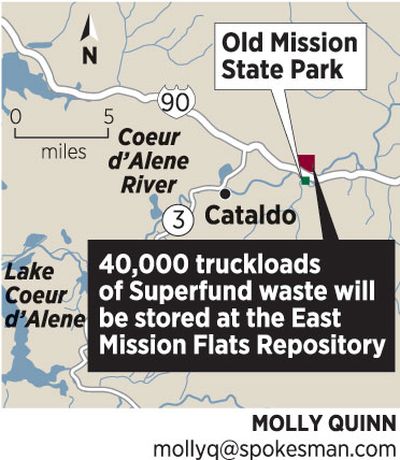Repository shipments begin
East Mission Flats site will hold mine waste from Superfund cleanup

Shipments of mine waste started arriving at the East Mission Flats repository Monday, after a top Superfund official endorsed a plan to store 40,000 truckloads of soil tainted with heavy metals in the Coeur d’Alene River’s floodplain.
Mathy Stanislaus expressed confidence in the repository’s ability to protect groundwater during a conference call with reporters. But he also said an “early warning system” will be installed to address concerns about potential contamination during floods. Additional monitoring wells at the repository will alert officials if metals start leaching into the groundwater.
Stanislaus is the Obama administration’s senior appointee on Superfund issues at the Environmental Protection Agency. He visited the Silver Valley in August, after U.S. Rep. Walt Minnick, D-Idaho, called EPA Administrator Lisa Jackson and asked that the repository be examined at the highest levels.
The 14-acre repository lies across Interstate 90 from Old Mission State Park. A citizens group, the Silver Valley Community Resource Center, and the Coeur d’Alene Tribe have raised concerns about storing waste in an unlined repository in an area that floods regularly. The waste, generated by Superfund cleanup in Idaho’s Silver Valley, contains arsenic, lead and other metals.
The repository’s proximity to the Old Mission at Cataldo is also controversial. Built in the 1850s by Jesuit priests and the Coeur d’Alene Tribe’s ancestors, the church is Idaho’s oldest building.
“This stuff is going to flow downstream,” said Barbara Miller, who heads the Silver Valley Community Resource Center. “EPA has missed the message about … risk exposure.”
Miller also said she hopes to see more downstream residents take an interest. “If they want to keep a quality of life, if they don’t want to be concerned about lead and heavy metal exposure, if they want clean drinking water, they need to get involved,” she said.
The Coeur d’Alene Tribe hadn’t received official notification of Stanislaus’ decision Monday afternoon. In a brief statement, Marc Stewart, the tribe’s spokesman, said the outcome – while expected – was disappointing.
EPA officials said the repository is needed to keep cleanup efforts on track. To reduce children’s blood-lead levels, the EPA is paying for tainted dirt to be removed from Silver Valley yards and replaced with clean soil. About $15 million in federal stimulus money is supporting the effort.
The Silver Valley is already home to several repositories, and plans are under way for another new repository in the upper Coeur d’Alene Basin. Over the next 25 years, federal and state agencies estimate that they’ll need storage space for 600,000 truckloads of mining waste generated from Superfund cleanup.
East Mission Flats already contains 35 million tons of contaminated soil deposited in the floodplain by the river, or dredged up and put there by mining companies during the early 1900s. The waste that will be taken to the repository actually has lower lead and zinc concentrations than the surrounding floodplain, said Andy Mork, the Idaho Department of Environmental Quality’s repository program manager.
Though the EPA is paying for most of the repository’s construction, the DEQ will manage it.
Water quality monitoring started at the site in late 2007, with six wells now tracking heavy metals in the groundwater, Mork said. The water flowing under East Mission Flats meets federal drinking water standards. Only one violation for arsenic has occurred, and it was upstream of the repository, Mork said.
The early warning system will monitor the moisture content of the repository’s waste, which will be capped with clean soil and stored in 32-foot mounds. At the Silver Valley Community Resource Center’s request, the EPA’s Office of Inspector General conducted an independent review of the repository’s design and issued a report in June.
The report said “the potential exists for the base of the repository to become saturated” during flooding, Mork said. But he said that metals would leach out of the mine waste only under limited “geochemical conditions.”
After the report was issued, two EPA experts reviewed the repository’s design and found it technically sound, said Angela Chung, EPA’s Bunker Hill Superfund team leader. Their review satisfied the inspector general, she said.
Stanislaus said that members of public will get a chance to comment on the early alert system’s design. It will go out for review in October. The early alert system will be in place before next year’s spring floods begin, Chung said.
If leaching occurs, water diversions or pumping could be used to stop it, Chung said. As a last resort, the repository could be shut down, she said.